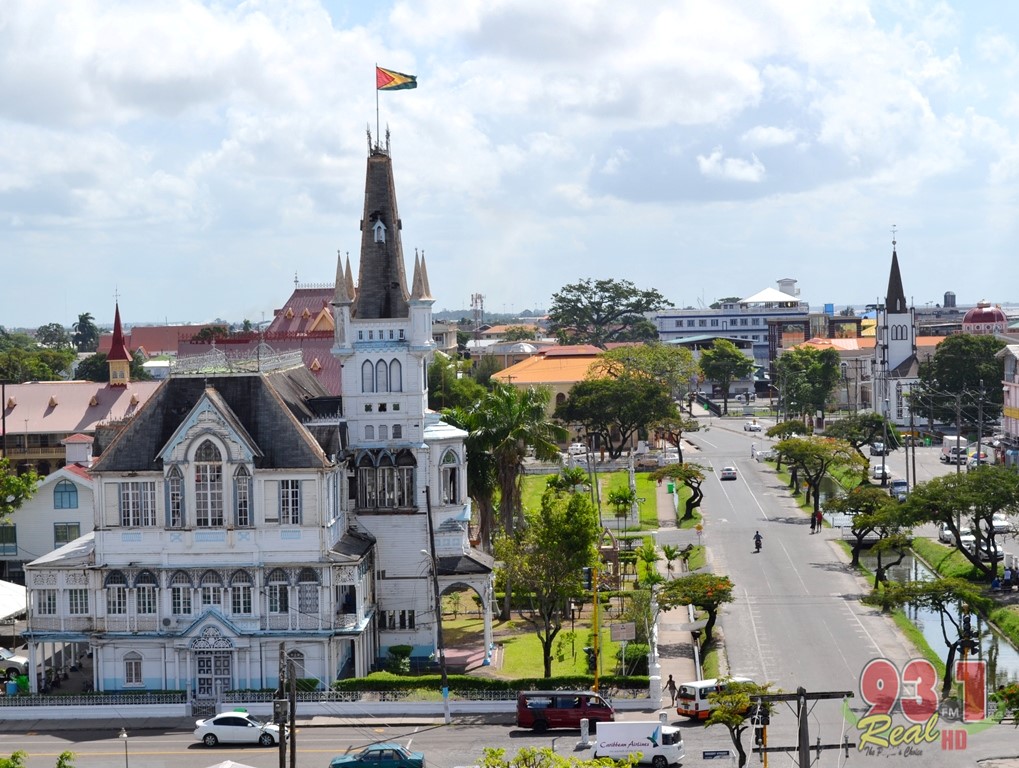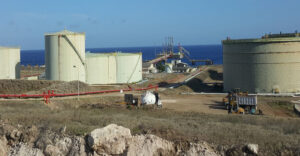
(Energy Analytics Institute, 22.Mar.2021) — Commentaries, quotes, data and other highlights from the Guyana Basins Summit (GBS) held virtually from 17-19 March 2021 and from speakers from Guyana’s President Mohamed Irfaan Ali to Guyana’s Natural Resources Minister Vickram Bharrat and others speaking about lessons learnt in other countries such as Nigeria and Brazil and efforts Guyana must take to avoid the “Dutch Disease.”
Guyana President Mohamed Irfaan Ali
— “Guyana is set to become an economic and energy epicenter in the western hemisphere. It is also destined to emerge as one of the most diversified regional economies.”
— “The country is dedicated to attracting large scale private investment in traditional and newly emerging sectors, investing in transformative infrastructure, developing world-class services including social services, and laying the groundwork for structural transformation.”
— “The government’s plans span from large scale agricultural investments and related projects to mega infrastructure projects which include bridges, a road to Brazil, a deep-water harbor, housing communities and urban centers, port facilities and digital technology backed by industrial parks and energy development.”
— “Guyana is in talks with Suriname about an energy corridor including Brazil and French Guiana as well will play important roles in the development.”
— “There is no reason for our country to be poor or for our people to want. Our resources must be used for the benefit of the people of Guyana.”
— “The Guyana Basin is an important natural resource. The total basin potential is about twice our proven reserves.”
— “Liza Phase 1 already achieved [production of] around 130,000 b/d. Liza Phase 2 is to commence production next year (2022); and by the end of 2027 we expect at least seven FPSOs to be producing well over 1 million barrels per day.”
Guyana’s Natural Resources Minister Vickram Bharrat
— Exxon, Hess and CNOOC have made 18 significant discoveries with over 9 billion equivalent barrels.
— “May I propose that the long-lost city of El Dorado appears to have been found. Oil being the black gold of the extractive industry.”
— “We’re working to avoid the Dutch Disease.”
— The regulator body to regulate the industry is expected to be in place by the end of 2021
— We anticipate the gas to shore project coming on stream in late 2023. The country’s energy costs will be lowered substantially.
— “Guyana and Suriname exploring bilateral ties and projects. Looking to close gaps between the two countries. The Guyana-Suriname bridge and deep water-harbor are high on the agenda. Countries have agreed to remove restrictions on market access.”
Omar Farouk Ibrahim, Secretary General of the African Petroleum Producer’s Organization (APPO)
— “Guyana is a late comer to producing countries and should be able to learn from mistakes from others that made them fall victim to the resource curse. Guyana must address challenges of the energy transition while developing its resources.”
— “Countries should not rush to sign contracts that they will eventually regret.”
— “The countries now championing the end of fossil fuel use are the very ones with the capacity to develop the technology to mitigate the environmental hazards of oil and thereby elongate the life of petroleum. But as we all know they are determined not to do this even if we are willing to fund the projects.”
— “Invest the bulk of what you make from oil in the education of your people. Invest in technology, Invest in artificial intelligence and invest all those things that will make the Guyanese economy strong even in the absence of oil wealth.”
— “What Guyana needs to focus on: contractual framework, local content, while thinking realistically about how long will the oil and gas sector last.”
Annand Jagesar, Acting Managing Director/CEO of Staatsolie Maatschappij Suriname N.V.
— First oil offshore Suriname in Block 58 is only five years away, he said referring to developments by Apache and Total.
— “Apache and Total are in the appraisal stage, they have brought in one rig, and will continue with two rigs; 2025 first oil will flow from the first development on Block 58 where Staatsolie has the right to participate for 20% in the development.”
— “Staatsolie is a great counterpart to do business with. We are open for business and really want to develop local content.
— “Staatsolie is an integrated energy company that has been around for 40 years, first oil came online in 1982. The company has reserves of 89 million barrels (MMbbls), annual production of 6 MMbbls, annual sales of 5.6 MMbbls and annual revenues $500mn. The company has an R/P ratio of around 15 years. The company has a staff of 1,131 employees of which 32% are female. The company has 180 MW of hydropower and 96 MW of thermal power.”
— “Staatsolie is looking to team up with local companies to help develop local content.”
International Association of Oil and Gas Producers (IOGP) Executive Director Iman Hill
— A “stable fiscal regime is a must as is an ability to honor contracts.”
Peter Ramsaroop, Chief Investment Officer and CEO, GO-Invest
— “We [Guyana] have 83,000 square miles of land, the size of Great Britain and the ability to continue to develop as we bring energy costs down and as we develop others sectors much faster than we would have in the past.”
— “Infrastructure and construction industry are starting to boom. Investments opportunities are not just in Guyana but in Suriname as well. We are open for investment, we will partner with you.”
Pierce Riemer, Director General, World Petroleum Council
— “Oil and gas are not running out. Our task is to use the resources in the future in an environmentally and socially responsible way.”
— “Guyana has achieved a lot in recent years, and it will not be long before they have the highest per capita oil production of any country in the world at around 1 barrel per person per day.”
“We still need to be more efficient. We need to reduce methane, flaring and venting, and we need to reduce carbon dioxide were we can. We need to adopt CCS and were sensible CCUS. Although there is a lot going on, it’s not enough, and what we really need to do now are far less initiatives and far more concrete actions.”
Bob Frylund, IHS Markit Chief Upstream Strategist
— “Countries need to leverage resources. Energy security has been redefined by the energy transition.”
— “The definition of energy transition has changed and the definition of upstream has changed.”
— “Reward people with carrots and not the stick …. Reward people.”
— “A lot can be learned from watching other countries, learning from their experiences.”
— “Guyana could be a 20 billion equivalent oil barrel basin.”
— “Transparency of all dealings is critical as well as is a clear vision of where they are going that is flexible and adaptable as the world changes.”
Pietro Ferreia, Senior Regional Analyst, Americas, Energy Industries Council (EIC)
— In Guyana, Payara FID and drilling activities are ongoing despite setbacks; in Brazil, Petrobras’ pre-salt portfolio has become a number one priority; and in Mexico, the government is keen on recovering Pemex’s production rates.
— In Guyana, Exxon has announced its FID for the Payara development, the company’s third one offshore in the Stabroek Block, and drilling activities are ongoing despite setbacks. The Unity FPSO topsides have been lifted, while construction of Prosperity FPSO topsides is ongoing. The Yellowtail expected to be ExxonMobil’s fourth development phase. On the Orinduik block, the exploration period has been extended until 2023. There is potential for 10 FPSOs in the Stabroek Block, with five units operating by 2026.
— In Suriname: in Block 58, Apache and Total expect to announce a FID in 2021.
— Major FPSO awards between 2016-2021 have been dominated by deals in Brazil, Guyana and Mexico with SBM Offshore and MODEC leading the market. Major subsea contract awards between 2016-2021 in the USA, Mexico, Guyana and Brazil have been dominated Technip FMC, Subsea 7 and McDermott, according to EIC.
Vandana Gangaram Panday, Offshore Strategy & Commercial Representative, Staatsolie
— “Staatsolie has a distinct role since by law in Suriname the NOC has a dual role, being both an oil regulator responsible for executing the hydrocarbon sectors institutional task and duties on behalf of the state and we are the commercial operator and we have been so since the early 80s.”
— In mid-November Staatsolie launched a shallow offshore bid round where we are offering eight blocks on the shelf. The interest so far has been above expectation with over 20 companies registered and a number of data packages have been sold. The deadline to submit bids is 30 April 2021.
— “We are also preparing for a multi-client 3D seismic survey also in the shadow offshore area where we have invited seismic contractors and the process is ongoing. Also, in the second quarter 2021 we will be receiving bids and awarding that contract. So later this year in the second half of this year we will see a multi-client in the shadow offshore which will help us prepare for the next shallow offshore bid round most likely in early 2023.”
Richard Donnellan, Tullow Oil plc, Suriname Country Representative
— “The company [Staatsolie] has safeguarded the integrity of the PSC’s that we’ve signed with them over the past few years. There’s been no discussion about changing terms and conditions of the PSCs while we’ve been going into operations, and that’s a real pleasure to see, and it backs up the professionalism of the regulation we work with.”
Ranti Omole, Chairman/CEO at Radial Circle Technical Services Limited
— “Local content is more about domestication of capacity, encouraging local investments, ownership of assets, transferring technology or acquiring technology or acquiring competence through collaborations with local service companies, international services companies, regional services companies so that local companies can have assets to develop. The local content is creating multiplier effect, impacting gross domestic product (GDP) and enabling other sectors.”
Willem Bloem, Principal at Bloem Consultants LLC
— “Suriname is now hot on the heels of Guyana as a global exploration success story.”
— “Staatsolie is also running a farmout process for eight blocks in the western part of the shallow water offshore. This is in a promising geological setting and just updip from the recent discoveries. So bids for these six year programs are due at the end of next month.”
Nuertey Adzeman, Executive Director Ghana Oil & Gas Service Providers Association Accra
— “Technical skills will allow you to get immediate work and when projects are done can be transferred to other industries.”
— “Local participation is key and needs to be built in the value chain. Guyana and Suriname have an opportunity to learn from best practices in Ghana and Nigeria.”
Ashni K. Singh, Senior Finance Minister, Trinidad and Tobago Government
— The Guyana government will respect the rule of law. The government is committed to democratic behavior and maintaining a strong macroeconomic environment for doing business.”
— “The government understands oil will drive economy in coming years but is committed to developing other sectors… and is looking to upgrade roads from Guyana to Brazil and discussing bridging current ferry route from Georgetown to Paramaribo.”
— “The government wants to avoid the perils that have overcome many resource-rich countries… and is looking to support investment in supportive infrastructure; investing in domestic transport infrastructure as well.”
— “The government will invest in human capital to boost potential local work force… and is working to strengthen government institutions.”
Nelson Narciso, President at NNF Energy Consultancy
— Brazil doesn’t have a local content law. The contracts have a specific clause that defines the local content requirements.
— “An international company that establishes a company in Brazil doesn’t mean that the company is complying with the local content. Local content per the Brazilian constitution is a company registered in Brazil that pays duties in Brazil and employs Brazilian or foreigners with working visas.”
— “Before defining local content strategic it is suggested Guyana and Suriname develop local capacity and local industry capacity as well.”
— “The best way forward is to have a strong regulator is necessary that can adapt to the rule with development of the country.”
Susan Sakmar, Visiting Professor, Univ. of Houston Law. Author: Energy for the 21st Century: Opportunities and Challenges for LNG
— “When you talk about natural gas, storage is critical and important and can play an important role.”
— “There should be diversity of power supply, natural gas, renewables maybe hydro because then you can keep the power on twenty-four seven 365 days out of the year, which is what I think consumers want, and I think that should be the goal of governments developing power for their countries.”
Yusuf Usman, Project Development Advisor
— “Gas is a catalyst for sustainable development in Nigeria since it has potential to enhance gas-based industry, thereby creating employment, increasing our GDP. We also see gas as an enabler to produce fertilizer.”
— “[In Nigeria], we hope we can use gas to enhance economic development and prosperity.”
— “In Africa, what we see is where we need energy, because we need to power Africa, then we need food. So, we need to enhance food production.”
— “As we’re looking at shrinking funding for natural gas, then for places like the Africa the conversation has to be: should we promote natural gas for food, natural gas for industrialization, or should we promote natural gas for lighting Africa. Once the funding for natural gas shrinks, then the hope for prosperity for Africa will be affected. We need natural gas as a transition fuel to promote prosperity for Africa.”
Kevin Ramnarine, Energy Consultant, Former Government Minister, Lecturer
— “Natural gas means electricity, and electricity means progress, development and a better standard of living.”
— “Electricity is an obstacle to doing business in Guyana, according to many businessmen from the point of view of reliability and the price of electricity.”
— “Trinidad has some of the lowest rates in the Western Hemisphere: residents pay between $0.04/kWh to $0.06/kWh. In Guyana, the price is probably five to six times that and they generate most of their electricity from fuel oil.”
— Electricity power generation is a high priority for the government.
— “Exxon has been producing since December 2019 oil and associated gas. Some of the gas is used for re-injection to maintain reservoir pressure and sustain oil production, and some of that gas is used for power generation on the FPSO.”
— “Since natural gas is the cleanest burning fossil fuel, so by switching out fuel oil for natural gas, Guyana would be reducing its carbon footprint. The [gas-to-shore] project is a win, win, win for Guyana from an economic, environment and social point of view.
— “Trinidad is only one of two countries in the world that generates all its electricity from natural gas, the other country that does that is Qatar.”
Francisco Monaldi, Baker Institute Fellow and Director of the Latin America Energy Program
— “Venezuela at its peak in the 1950s when it was the richest country in Latin America by far was producing about 50 barrels per capita per year, and Guyana is probably going to produce 400 barrels per capita per year.”
— “Strong checks and balances in the political realm are necessary so that this doesn’t become a rent seeking fight for those resources and you’re able to have long term policies that do not radically change when there is a change in government or the people working at certain ministries. I think this is the hardest but the most essential element to under pin the rest of the institutional framework.”
Heloisa Borges Esteves, Director Empresa de Pesquisa Energética
— “Brazil’s proven natural gas reserves range around 360 billion cubic meters and we expect to be producing around 200 million cubic meters per day by the end of 2030, mostly offshore. Currently, around 86% of Brazil’s gas production is associated and 84% comes from offshore basins.”
— “We expected natural gas production to double in the next ten years and we need infrastructure to make that projection a reality.”
— In Brazil, gas is key to the country’s long-term energy plan and the country is expected it to be a significant contributor amid its energy transition strategy.”
— “The main issue we face now is where’s the demand for natural gas.”
____________________
By Ian Silverman and Piero Stewart. © Energy Analytics Institute (EAI). All Rights Reserved.

